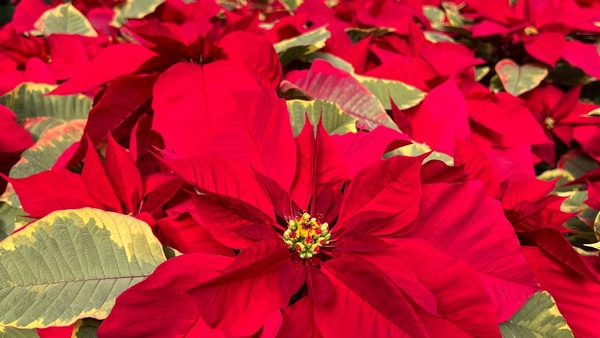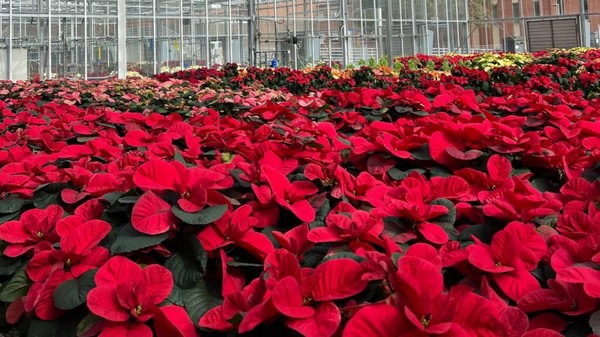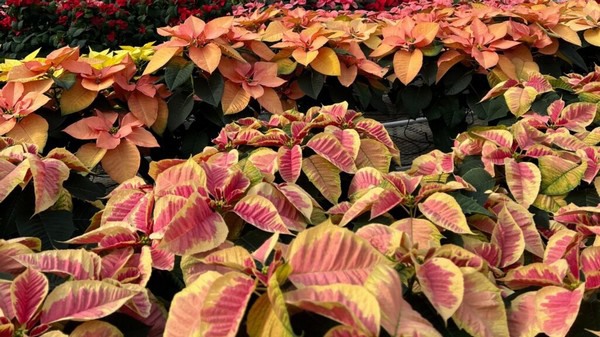The holidays are approaching quickly, and you might be scurrying to add the last few ornaments to your Christmas tree or purchase last-minute gifts for friends and family. But Brian Jackson, a professor in the Department of Horticultural Science, started his holiday season in July by planting nearly a thousand poinsettias.
Now, he's 'wrapping' his data collection and giving most of the poinsettias to friends and family, as well as faculty, staff, and colleagues across campus. He has followed a similar process for nearly a decade in NC State's Horticultural Substrates Lab to study how to grow poinsettias using engineered wood fibers instead of traditional growing media composed primarily of peat moss.

Growing poinsettias without soil
Jackson's interest in soilless horticulture began while growing up on a tobacco farm in Lumberton, North Carolina, when he was just 16 years old.
"I visited the largest tobacco grower in our community who had just built a greenhouse and started to grow his tobacco plants in soilless culture," Jackson says. "I saw thousands of floating styrofoam trays with baby tobacco plants growing in peat or soilless media, and it was like walking onto the surface of Mars as far as really cool technology. I've spent the rest of my life trying to have some role in innovation in the soilless production world."
He pursued a bachelor's degree in horticulture from NC State, a master's degree from Auburn University, and a Ph.D. from Virginia Tech before returning to NC State's Department of Horticultural Science as a faculty member. The Horticultural Substrates Lab is among the largest in the U.S. and one of few worldwide devoted to studying and developing soilless growing media.

Mineral soil is rarely used today in the container production of horticultural crops. Instead, peat moss, aged barks, coconut coir, composts, wood fiber, and other soilless options are used because they are lighter in weight, contain fewer pathogens, and allow for more precision-based growing because the water can be managed better.
Peat, the most used material for growing plants over the past seven decades, is extracted from natural bogs in Canada, Northern Europe, and other places around the globe, and there's a push to find more sustainable and cost-friendly options. Jackson's lab uses locally sourced engineered wood products instead of or in addition to peat. Along with their beauty, Jackson uses poinsettias in his research because they are good indicators, or model, plants.
"When we're looking at soilless substrates or fertility, we want to choose a plant that's going to tell us if it's happy or not," says Jackson.
Peat alternatives, including the wood fibers in Jackson's lab, are being adopted and adapted by professional growing producers.
"Some of the largest greenhouse plant producers in the state, as well as the nation, have begun to use some of the materials we've helped to develop, not only in saving money but also in times of supply shortages that we've seen in the past three years due to the pandemic. It's nice when research has an immediate implication for the stakeholders who we serve. That means a lot to me as a PI and certainly to my graduate students as well."
This year's poinsettias
Jackson's poinsettias grow for 12-14 weeks, depending on the variety and the research objectives. This year, he grew 850 plants with 13 different varieties, but he's grown as many as 2,500 in a single season.
His research questions change based on growers' needs, but his lab's primary focus this year is to see how high a percentage of wood fiber can be used to grow crops. He's also studying how to precondition the fresh wood substrate products better since natural resins and sap from trees can be harmful to plants.

"We're trying to find ways to remove or mitigate those toxins in an easy and cheap way so that when we use fresh wood products, that is not one of the inhibiting factors that cause the plants not to be happy," Jackson says.
Jackson's greenhouse includes poinsettias in different shades of red, pink, and white, in addition to different sizes and shapes. However, red is still the most popular color among consumers.
"People are pretty traditional with certain things, including poinsettias, that they've always known to be familiar to them," says Jackson. "Red has been the staple for so many decades, well before the development of so many of our new genetics and colors."
New orange and yellow colors are now in the greenhouse, and the hope is to expand the poinsettia market beyond the winter holiday season.
Jackson adds, "There are really neat poinsettias that will pretty much fit the interest and personality of any consumer."
For more information:
North Carolina State University
www.ncsu.edu
